Gray zone lymphoma effectively treated with cyclophosphamide,doxorubicin,vincristine,prednisolone,and rituximab chemotherapy:A case report
lNTRODUCTlON
B-cell lymphoma,unclassifiable,with features intermediate between diffuse large B-cell lymphoma and classical Hodgkin lymphoma(BCLu-DLBCL/cHL),also referred to as GZL,was first recognized in the World Health Organization(WHO)classification of lymphoid neoplasms in 2008[1,2].The recognition of the disease as a distinct pathological and clinical entity has increased,although its diagnosis remains complex[3].The diagnostic category was formally included in the WHO classification,which defined the histological and immunophenotypic criteria.In general,GZL tends to have a more aggressive clinical course and is associated with poorer outcomes than either cHL or primary mediastinal large Bcell lymphoma(PMBL).The application of rituximab chemotherapy appears to be beneficial for improving GZL patient outcomes[4,5].
It was the first day of class. Two of her new ESL classmates wanted to know where Tara was from. They were both from Iraq. Because Tara looked Iraqi, one of the women asked Tara, in English, if she was from Iraq. Tara replied, No, I m not. Then the women took turns asking Tara if she was from Iran, or Syria, or Jordan. To each question, Tara responded1 with a simple no. Laughing, one woman said to the other, She s not from anywhere! The two went to their desks, talking to each other in Arabic2.
Here,we report the case of a patient with GZL,which is rare in Asian populations[6-9],who was successfully treated with cyclophosphamide,doxorubicin,vincristine,prednisolone,and rituximab(RCHOP)chemotherapy.
CASE PRESENTATlON
Chief complaints
A 69-year-old female presented at the surgical outpatient department of our hospital with a growing mass on the right side of her neck.
In the Cupid and Psyche tale as recorded by Apuleius, Psyche is pregnant throughout her search for the missing Cupid. The baby, named Pleasure, is born after she is reunited with Cupid. Later versions of the tale, such as the one by Thomas Bulfinch, omit this detail.
History of present illness
The patient was admitted to the hospital for further examination and treatment.The patient had no B symptoms,such as fever,night sweats,or weight loss.
History of past illness
The patient had a past medical history of subarachnoid hemorrhage resulting in the impairment of higher cognitive functions at 61 years of age.
Personal and family history
Laboratory analyses showed pancytopenia(white blood cells,1500/μL;red blood cells,371 × 10
/μL;hemoglobin,10.7 g/dL;mean corpuscular volume,87.3 fL;and platelets,5.0 × 10
/μL),increased serum lactate dehydrogenase levels(451 U/L;reference value 124-222 U/L),and markedly increased levels of soluble interleukin-2 receptor(6220 U/mL;reference value 145-519 U/mL).
Physical examination
Anemia was suspected based on the color of the palpebral conjunctiva.An elastic,soft mass measuring 9 cm × 6 cm was palpable in the right cervical region.Other superficial lymph nodes and the liver and spleen were not palpable.An increased bleeding tendency was not observed.
Laboratory examinations
There was no personal history of tobacco or alcohol consumption or any other family medical history.
Recently,brentuximab vedotin,an anti-CD30 antibody,has been used to treat Hodgkin lymphoma and CD30-positive lymphoma[9,26,27].Pembrolizumab,an anti-PD-L1 monoclonal antibody,is also used for patients with refractory GZL[28].If the response to the abovementioned chemotherapy regimens is poor,tandem high-dose chemotherapy supported by autologous stem cell transplantations and consolidative radiotherapy can be considered[29].In this case,the tumor cells were CD20+,and the patient was initially treated with one cycle of CHOP followed by five cycles of R-CHOP chemotherapy.She has remained in complete remission for 3 years.These regimens can also be considered for treating recurrent disease.
Imaging examinations
It was a Princess who was standing2 outside the door. What with the rain and the wind, she was in a sad condition; the water trickled3 down from her hair, and her clothes clung to her body. She said she was a real Princess.
MULTlDlSClPLlNARY EXPERT CONSULTATlON
Makoto Nagasaki,MD,PhD,Chief of Clinical Laboratory,Department of Pathology,National Hospital Organization Hamada Medical Center
A bone marrow biopsy was obtained from the iliac crest.Fine-needle biopsies were obtained from the right cervical mass(supraclavicular lymph node).Pathological examinations were performed using immunohistochemical(IHC)studies and outsourced flow cytometry(FCM).IHC staining and Epstein-Barr virus(EBV)-encoded small RNA in situ hybridization(EBER-ISH)were performed using standard methods with an automated immunostainer(Ventana Benchmark Ultra,Tucson,AZ,United States).Antibodies against the following markers were used: CD20(L26,Ventana),CD3(GV6,Ventana),CD30(BerH2,Ventana),CD15(MMA,Ventana),PAX5(DAKO-Pax5,Dako,Agilent Technologies,Inc.,Santa Clara,CA,USA),CD45(PD7/26,2B11,Nichirei Biosciences,Tokyo,Japan),OCT2(Oct-207,Leica Biosystems,Wetzlar,Germany),BOB1(TG14,Leica),CD79a(JCB117,Nichirei),MUM1(MUM1p,Dako),and ALK(ALK1,Dako).Appropriate positive controls were used for IHC staining.The immunostaining of programmed cell death protein ligand 1(PD-L1)(clone SP142,Ventana OptiView,Roche)was outsourced.
Histopathological analysis of the iliac crest biopsy revealed hemophagocytosis without bone marrow infiltration.Supraclavicular lymph nodes were infiltrated by large,atypical,and pleomorphic cells(Figure 3).These cells showed sheet-like proliferation and were scattered among the inflammatory cells[small lymphocytes(CD3+T-cells)and histiocytes].These large,atypical cells,including Hodgkin and Reed-Sternberg cells or lacunar-like cells,were immunohistochemically positive for CD20,CD79a,CD30,CD45,OCT2,BOB1(focally),PAX5,and MUM1 but negative for CD15 and ALK.EBV was not detected by EBER-ISH(some of the results are shown in Figure 4).CD20 and PAX5 expression levels were strong,and CD30 expression levels were variable(weak to strong).Nearly 50% of the lymphoma cells were MUM1-positive.As shown in Figure 5,PD-L1 expression(clone SP142)was found in > 75% of the tumor cells(neoplastic PD-L1).Clonal expression of surface and cytoplasmic light chains(sIg and cyIg,respectively)was not detected by FCM(sIg,kappa 12.5%,lambda 12.9%;cyIg,kappa 13.2%,lambda 11.9%).On the other hand,immunoglobulin heavy chain gene rearrangement was detected(data not shown).
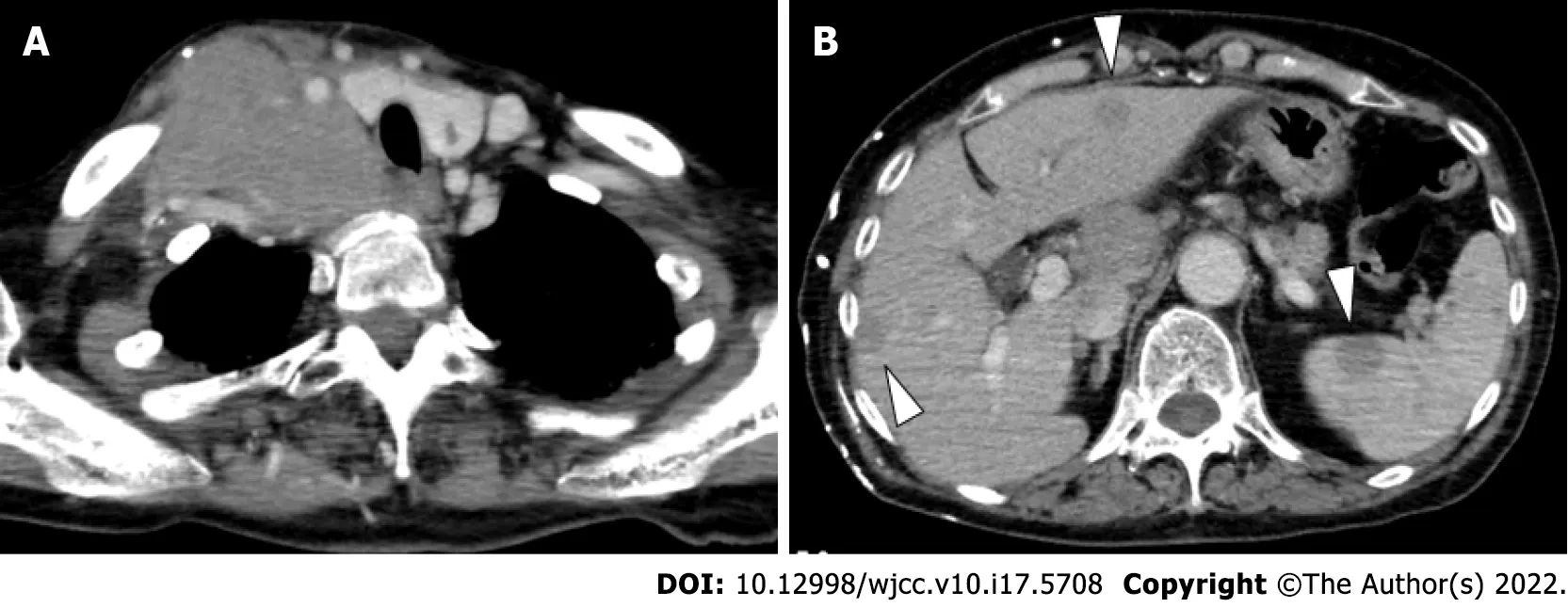
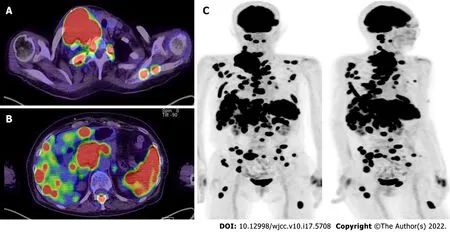
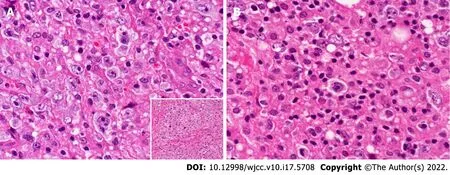
FlNAL DlAGNOSlS
The patient was diagnosed with stage IV GZL according to the Lugano classification,the International Prognostic Index 4(high-risk lymphoma)for aggressive non-Hodgkin lymphoma,and the International Prognostic Score 4 for Hodgkin lymphoma.
TREATMENT
The patient was initially treated with a reduced dose(60% of the scheduled dose)of CHOP chemotherapy to prevent tumor lysis syndrome,and it was initially unclear whether the tumor cells were CD20-positive.Subsequently,five cycles of R-CHOP chemotherapy were administered at standard doses.
OUTCOME AND FOLLOW-UP
GZL can be divided into mediastinal GZL(MGZL)and nonmediastinal GZL(NMGZL)depending on the presence or absence of mediastinal lesions,and there are several clinical differences between these two subtypes.It has been reported that patients with MGZL more commonly have bulky disease than patients with NMGZL.Patients with NMGZL are typically significantly older,have a higher likelihood of bone marrow involvement,more often have extranodal disease sites,and present much more commonly with advanced-stage disease[5].The patient in this case was elderly,had bone marrow involvement,and was diagnosed with advanced-stage disease;therefore,the patient’s clinical manifestations were similar to those of NMGZL.
DlSCUSSlON
GZL is known to share features with cHL and DLBCL;however,it is often difficult to diagnose[10].The differential diagnosis of the present case included DLBCL[common DLBCL with CD30 expression and anaplastic variant DLBCL(avDLBCL)],T-cell/histiocyte-rich large B-cell lymphoma(THRLBCL),PMBL,and cHL.
Tsarevitch Ivan wept bitterly over the loss of his horse. The whole day he walked, till his weariness could not be told in a tale. He was near to faint from weakness, when again he met the Gray Wolf. Thou art a brave lad, Tsarevitch Ivan, said the Wolf, and for this reason I feel pity for thee. I have eaten thy good horse, but I will serve thee a service in payment. Sit now on my back and say whither I shall bear thee and wherefore.
Regarding the clinical manifestations,the patient had an elastic,soft mass in the right cervical region.Enhanced CT and fluorodeoxyglucose PET/CT revealed abnormal lymph node enlargement in the right neck,right clavicular region,and anterior mediastinum.Multiple lesions in the lymph nodes throughout the body,including the liver,spleen,and multiple bones,were also found.DLBCL involves nodal or extranodal lesions in any location,including the liver,spleen,and bone marrow[11].THRLBCL mainly involves the lymph nodes,but bone marrow,liver,and spleen involvement is frequently found[12].CHL also involves the liver,spleen,and bone marrow[13].PMBL usually lacks bone marrow lesions[14].Therefore,PMBL was excluded from the differential diagnosis.The most common presentation of GZL is a large anterior mediastinal mass,with or without the involvement of supraclavicular lymph nodes.The tumor may spread directly to the lung,and spread to the liver,spleen,and bone marrow can also be observed[5].
Pathologically,the distribution of large,atypical cells,including centroblastic cells and lacunar-like cells,varied from sheet-like to scattered(with predominantly sheet-like proliferation).Except for the moderate expression of MUM1,the immunophenotype of the tumor cells[positive for CD30(variable expression)and CD20(diffuse,strong expression),and negative for CD15]was compatible with the diagnosis of consensus-confirmed GZL but not with cHL[10].The Lymphoma Study Association has proposed a classification system for GZL with four subcategories based on the morphological and phenotypical spectrum[15].According to this classification system,the patient’s tumor was categorized into the transitional group of cHL-like GZL and large B-cell lymphoma-like GZL.The FCM analysis of the same pathologic specimen did not detect clonal sIg and cyIg expression,although CD20+B-cells represented a minor population in the gated fraction.Kappa or lambda Ig expression in large tumor cells cannot be estimated by IHC due to background staining.Strong nuclear expression of OCT2 was present in > 50% of the cells;on the other hand,most of the cells were weak to faintly positive for BOB1(Figure 4E and F),with strong expression observed in only 7.5%(Figure 4E and F,inserted).As previously reported,positive evaluation of OCT2 and BOB1 was based on at least 30% of large tumor cells[16-18],and in one study,strong staining intensity was also a condition[17].Thus,we interpreted the focal positive BOB1 expression as abnormal in the present case.The focal expression of BOB1 and lack of detectable clonal expression of sIg and cyIg in the FCM analysis were possibly related to abnormal regulation of immunoglobulin expression,similar to cHL but not ordinal DLBCL.The findings were not compatible with the diagnosis of THRLBCL due to the presence of a sheet-like growth area and the positive expression of CD30.Because the primary site of the tumor was not considered to be the mediastinum,PMBL was not considered.Because large tumor cells did not display a sinusoidal growth pattern,the diagnosis of avDLBCL was incompatible.
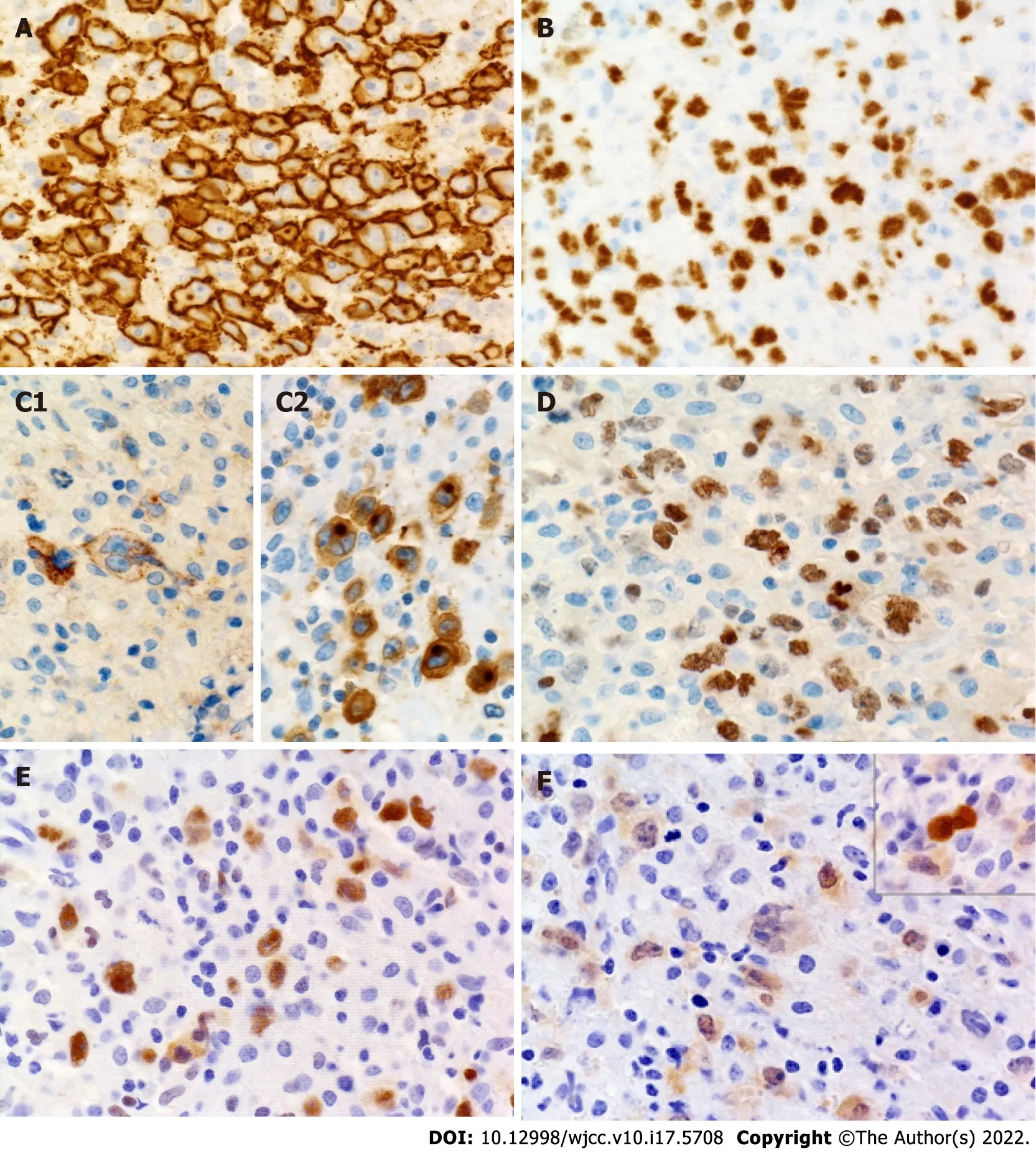
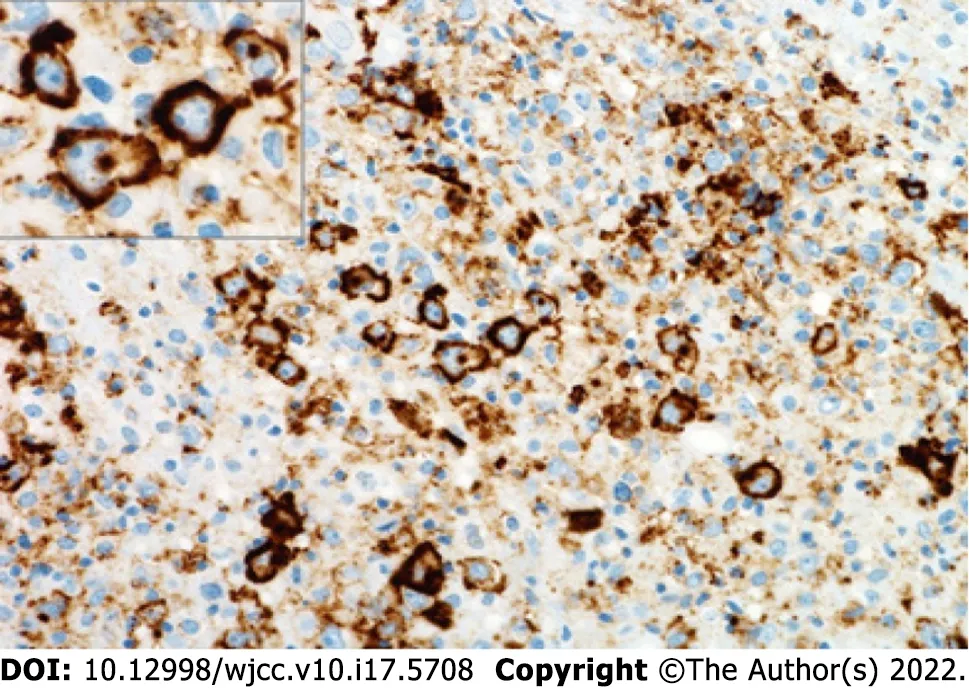
Recently,neoplastic PD-L1 has been found to be a useful marker of GZL[17-20],enabling researchers to differentiate GZL from nodal avDLBCL[18].We detected abundant PD-L1-positive(clone SP142)large lymphoma cells(75%)without an EBV association(EBER-ISH negative).Tanaka
[20]reported PD-L1 IHC expression(30% cut off)in 77% of GZL cases(10/13).Sakakibara
[21]reviewed PD-L1 expression(clone SP142)and found it to be useful for the diagnosis of GZL(Nodal DLBCL,EBVnegative 0/275(0%);Nodal GZL,EBV-negative 3/3(100%);Nodal avDLBCL,EBV-negative 0/11(0%).Considering these findings,we diagnosed this patient with nodal GZL.
Enhanced CT(Figure 1)and fluorodeoxyglucose PET /CT(Figure 2)revealed multiple lesions throughout the patient’s body,including the right neck.
The patient achieved complete remission and has remained in complete remission for 3 years since the last chemotherapy session.
Most reported cases of GZL have been in Caucasian and Hispanic individuals,and its incidence is lower in African-American and Asian populations,including the Japanese population[6,7].Therefore,reporting cases of rare diseases is important,especially when these diseases occur in regions where they are usually not prevalent.This practice aids in investigating the factors underlying the epidemiology of the disease.
Written informed consent was obtained from the patient for the publication of this study and any accompanying images.
13.Her old grandmother, the only person who had loved her: Andersen also had a grandmother who doted on him, whom he remembered fondly in his memoirs39 and honors in this tale.Return to place in story.
CONCLUSlON
GZL was diagnosed based on histopathology and immunophenotyping with ancillary PD-L1 positivity.R-CHOP chemotherapy was an effective treatment.
FOOTNOTES
Hojo N and Mihara Y were the patient’s doctors in charge,reviewed the literature and contributed to manuscript drafting;Nagasaki M was the patient’s pathologist,made the pathological diagnosis,reviewed the literature and contributed to manuscript drafting;and All authors issued final approval for this version to be submitted.
According to the National Comprehensive Cancer Network guidelines,aggressive large B-cell lymphoma treatment regimens are preferred for GZL,though there is no consensus regarding the optimal regimen.If the tumor cells are CD20+,the addition of rituximab to the chemotherapy regimen should be considered[22].R-CHOP or dose-adjusted etoposide,prednisolone,vincristine,cyclophosphamide,doxorubicin,and rituximab(DA-EPOCH-R)regimens are recommended[23-25].
The authors declare that have no conflicts of interest.
The authors have read the CARE Checklist(2016),and the manuscript was prepared and revised according to the CARE Checklist(2016).
And in the rain we crossed the road to a tea shop. I forget what we talked about. I remember being speechless with happiness and feeling that God, or someone, had brought us together. I ate three cakes; he pressed me to have a fourth but I didn t, in case it was vulgar. It was then he asked my name. So he had forgotten it.
This article is an open-access article that was selected by an in-house editor and fully peer-reviewed by external reviewers.It is distributed in accordance with the Creative Commons Attribution NonCommercial(CC BYNC 4.0)license,which permits others to distribute,remix,adapt,build upon this work non-commercially,and license their derivative works on different terms,provided the original work is properly cited and the use is noncommercial.See: https://creativecommons.org/Licenses/by-nc/4.0/
He spoke to the boy, and asked him why he was so unhappy; and the boy told him how he had sworn to bring the Terrible Head, and knew not how to begin to set about the adventure
Japan
In a narrow creek28 she found a whole troop of little human children, quite naked, and sporting about in the water; she wanted to play with them, but they fled in a great fright; and then a little black animal came to the water; it was a dog, but she did not know that, for she had never before seen one
Nobumasa Hojo 0000-0003-0880-0101;Makoto Nagasaki 0000-0002-1344-2364;Yasuha Mihara 0000-0001-8579-3748.
Ma YJ
A
Then the King remembered Jack my Hedgehog, and he told his daughter how he had been obliged to give a written promise to bestow10 whatever he first met when he got home on an extraordinary creature which had shown him the way
Ma YJ
1 Swerdlow SH,Campo E,Harris NL,Jaffe E,Pileri S,Stein H,Thiele J.WHO classification of tumours of haematopoietic and lymphoid tissues.4th ed.Lyon: International Agency for Research on Cancer,2008: 267-268
2 Campo E,Swerdlow SH,Harris NL,Pileri S,Stein H,Jaffe ES.The 2008 WHO classification of lymphoid neoplasms and beyond: evolving concepts and practical applications.
2011;117: 5019-5032[PMID: 21300984 DOI: 10.1182/blood-2011-01-293050]
3 Magyari F,Barna S,Miltényi Z,Rajnai H,Csomor J,Udvardy M,Illés á,Váróczy L.Histopathological difficulties in an adolescent lymphoma patient.
2015;21: 213-217[PMID: 24985032 DOI: 10.1007/s12253-014-9810-x]
4 Swerdlow SH,Campo E,Harris NL,Jaffe E,Pileri S,Stein H,Thiele J.WHO classification of tumours of haematopoietic and lymphoid tissues.Revised 4th ed.Lyon: International Agency for Research on Cancer,2008: 342-344
5 Evens AM,Kanakry JA,Sehn LH,Kritharis A,Feldman T,Kroll A,Gascoyne RD,Abramson JS,Petrich AM,Hernandez-Ilizaliturri FJ,Al-Mansour Z,Adeimy C,Hemminger J,Bartlett NL,Mato A,Caimi PF,Advani RH,Klein AK,Nabhan C,Smith SM,Fabregas JC,Lossos IS,Press OW,Fenske TS,Friedberg JW,Vose JM,Blum KA.Gray zone lymphoma with features intermediate between classical Hodgkin lymphoma and diffuse large B-cell lymphoma: characteristics,outcomes,and prognostication among a large multicenter cohort.
2015;90: 778-783[PMID: 26044261 DOI: 10.1002/ajh.24082]
6 Iwaki N,Sato Y,Kurokawa T,Maeda Y,Ohno K,Takeuchi M,Takata K,Orita Y,Nakao S,Yoshino T.B-cell lymphoma,unclassifiable,with features intermediate between diffuse large B-cell lymphoma and classical Hodgkin lymphoma without mediastinal disease: mimicking nodular sclerosis classical Hodgkin lymphoma.
2013;46: 172-176[PMID: 23512149 DOI: 10.1007/s00795-013-0038-8]
7 Shi F,Zhou Q,Gao Y,Cui XQ,Chang H.Primary splenic B-cell lymphoma,unclassifiable,with features intermediate between diffuse large B-cell lymphoma and classical Hodgkin lymphoma:A case report.
2016;12: 1925-1928[PMID: 27602118 DOI: 10.3892/ol.2016.4840]
8 Ebisawa K,Koya J,Shinozaki-Ushiku A,Nakamura F,Kurokawa M.Paraneoplastic limbic encephalitis in B cell lymphoma unclassifiable with features intermediate between diffuse large B cell lymphoma and classical Hodgkin lymphoma.
2016;95: 1011-1012[PMID: 26984106 DOI: 10.1007/s00277-016-2625-y]
9 Mallipudi RM,Alquran L,Shenoy VA,Leslie LA,Conti JA.A Rare Case of Grey Zone Lymphoma Successfully Treated with Brentuximab Vedotin and R-CHP Chemotherapy.
2019;2019: 4121234[PMID: 31110830 DOI: 10.1155/2019/4121234]
10 Pilichowska M,Pittaluga S,Ferry JA,Hemminger J,Chang H,Kanakry JA,Sehn LH,Feldman T,Abramson JS,Kritharis A,Hernandez-Ilizaliturri FJ,Lossos IS,Press OW,Fenske TS,Friedberg JW,Vose JM,Blum KA,Jagadeesh D,Woda B,Gupta GK,Gascoyne RD,Jaffe ES,Evens AM.Clinicopathologic consensus study of gray zone lymphoma with features intermediate between DLBCL and classical HL.
2017;1: 2600-2609[PMID: 29296913 DOI: 10.1182/bloodadvances.2017009472]
11 Sehn LH,Scott DW,Chhanabhai M,Berry B,Ruskova A,Berkahn L,Connors JM,Gascoyne RD.Impact of concordant and discordant bone marrow involvement on outcome in diffuse large B-cell lymphoma treated with R-CHOP.
2011;29: 1452-1457[PMID: 21383296 DOI: 10.1200/JCO.2010.33.3419]
12 Abramson JS.T-cell/histiocyte-rich B-cell lymphoma: biology,diagnosis,and management.
2006;11: 384-392[PMID: 16614234 DOI: 10.1634/theoncologist.11-4-384]
13 Shimabukuro-Vornhagen A,Haverkamp H,Engert A,Balleisen L,Majunke P,Heil G,Eich HT,Stein H,Diehl V,Josting A.Lymphocyte-rich classical Hodgkin's lymphoma: clinical presentation and treatment outcome in 100 patients treated within German Hodgkin's Study Group trials.
2005;23: 5739-5745[PMID: 16009944 DOI: 10.1200/JCO.2005.17.970]
14 Barth TF,Leith?user F,Joos S,Bentz M,M?ller P.Mediastinal(thymic)large B-cell lymphoma: where do we stand?
2002;3: 229-234[PMID: 12067685 DOI: 10.1016/s1470-2045(02)00714-3]
15 Sarkozy C,Copie-Bergman C,Damotte D,Ben-Neriah S,Burroni B,Cornillon J,Lemal R,Golfier C,Fabiani B,Chassagne-Clément C,Parrens M,Herbaux C,Xerri L,Bossard C,Laurent C,Cheminant M,Cartron G,Cabecadas J,Molina T,Salles G,Steidl C,Ghesquières H,Mottok A,Traverse-Glehen A.Gray-zone Lymphoma Between cHL and Large B-Cell Lymphoma:A Histopathologic Series From the LYSA.
2019;43: 341-351[PMID: 30540571 DOI: 10.1097/PAS.0000000000001198]
16 Gualco G,Natkunam Y,Bacchi CE.The spectrum of B-cell lymphoma,unclassifiable,with features intermediate between diffuse large B-cell lymphoma and classical Hodgkin lymphoma:A description of 10 cases.
2012;25: 661-674[PMID: 22222636 DOI: 10.1038/modpathol.2011.200]
17 O'Malley DP,Fedoriw Y,Weiss LM.Distinguishing Classical Hodgkin Lymphoma,Gray Zone Lymphoma,and Large Bcell Lymphoma:A Proposed Scoring System.
2016;24: 535-540[PMID: 26447896 DOI: 10.1097/PAI.0000000000000236]
18 Megahed NA,Kohno K,Sakakibara A,Eladl AE,Elsayed AA,Wu CC,Suzuki Y,Takahara T,Kato S,Nakamura S,Satou A,Asano N.Anaplastic variant of diffuse large B-cell lymphoma: Reappraisal as a nodal disease with sinusoidal involvement.
2019;69: 697-705[PMID: 31872533 DOI: 10.1111/pin.12871]
19 Kohno K,Suzuki Y,Harada T,Sakai A,Takeuchi Y,Inagaki Y,Megahed NA,Takahara T,Satou A,Sakakibara A,Nakamura S.Nodal diffuse large B-cell lymphoma with neoplastic PD-L1 positivity,but without EBV association: Three cases highlighting an aspect of gray zone lymphoma.
2020;70: 695-697[PMID: 32623805 DOI: 10.1111/pin.12982]
20 Tanaka Y,Maeshima AM,Nomoto J,Makita S,Fukuhara S,Munakata W,Maruyama D,Tobinai K,Kobayashi Y.Expression pattern of PD-L1 and PD-L2 in classical Hodgkin lymphoma,primary mediastinal large B-cell lymphoma,and gray zone lymphoma.
2018;100: 511-517[PMID: 29377256 DOI: 10.1111/ejh.13033]
21 Sakakibara A,Kohno K,Ishikawa E,Suzuki Y,Tsuyuki Y,Shimada S,Shimada K,Satou A,Takahara T,Ohashi A,Takahashi E,Kato S,Nakamura S,Asano N.Diagnostic utility of programmed cell death ligand 1(clone SP142)immunohistochemistry for malignant lymphoma and lymphoproliferative disorders: A brief review.
2021;61: 182-191[PMID: 34511582 DOI: 10.3960/jslrt.21003]
22 NCCN Guidelines for Patients.Diffuse large b-cell lymphoma,grey zone lymphoma(intermediate between DLBCL and classical HL).Version 2.Plymouth Meeting,PA: NCCN,2018
23 Kritharis A,Pilichowska M,Evens AM.How I manage patients with grey zone lymphoma.
2016;174: 345-350[PMID: 27301470 DOI: 10.1111/bjh.14174]
24 Chihara D,Westin JR,Miranda RN,Cheah CY,Oki Y,Turturro F,Romaguera JE,Neelapu SS,Nastoupil LJ,Fayad LE,Rodriguez MA,Fowler NH,Orlowski RZ,Wang M,Hagemeister FB,Medeiros LJ,Fanale MA.Dose adjusted-EPOCH-R and mediastinal disease may improve outcomes for patients with gray-zone lymphoma.
2017;179: 503-506[PMID: 27378601 DOI: 10.1111/bjh.14226]
25 Simon Z,Virga B,Pinczés L,Méhes G,Miltényi Z,Barna S,Szabó R,Illés á.Transition Between Diffuse Large B-Cell Lymphoma and Classical Hodgkin Lymphoma- Our Histopathological and Clinical Experience With Patients With Intermediate Lymphoma.
2021;27: 625529[PMID: 34257590 DOI: 10.3389/pore.2021.625529]
26 Terao T,Yuda J,Yamauchi N,Guo YM,Shimada K,Sugano M,Ishii G,Minami Y.Brentuximab vedotin maintenance after autologous stem cell transplantation for refractory gray zone lymphoma with long-term remission.
2021;14: 125[PMID: 33936598 DOI: 10.3892/mco.2021.2287]
27 Svoboda J,Bair SM,Landsburg DJ,Dwivedy Nasta S,Nagle SJ,Barta SK,Khan N,Filicko-O'Hara J,Gaballa S,Strelec L,Chong E,Mitnick S,Waite TS,King C,Ballard H,Youngman M,Gerson J,Plastaras JP,Maity A,Bogusz AM,Hung SS,Nakamura H,Nejati R,Steidl C,Lim M,Ruella M,Schuster SJ.Brentuximab vedotin in combination with rituximab,cyclophosphamide,doxorubicin,and prednisone as frontline treatment for patients with CD30-positive B-cell lymphomas.
2021;106: 1705-1713[PMID: 32414850 DOI: 10.3324/haematol.2019.238675]
28 Rosales YMZ,Mesquita JL,Garcia YDO,Paz FRF,Campos NCB,de Vasconcelos Leit?o JP,Filho FDR,Filho RVAO,Lemes RPG,Duarte FB.Use of checkpoint inhibitors in gray zone lymphoma.
2020[PMID: 32589932 DOI: 10.1016/j.hemonc.2020.06.001]
29 Takaishi K,Muto T,Mimura N,Takiguchi J,Nagao Y,Oshima-Hasegawa N,Tsukamoto S,Takeda Y,Mitsukawa S,Takeuchi M,Ohwada C,Ota S,Iseki T,Nakaseko C,Sakaida E.Long-term complete remission following tandem autologous stem cell transplantation and consolidative radiotherapy for refractory mediastinal gray-zone lymphoma.
2018;108: 452-455[PMID: 29786758 DOI: 10.1007/s12185-018-2471-x]
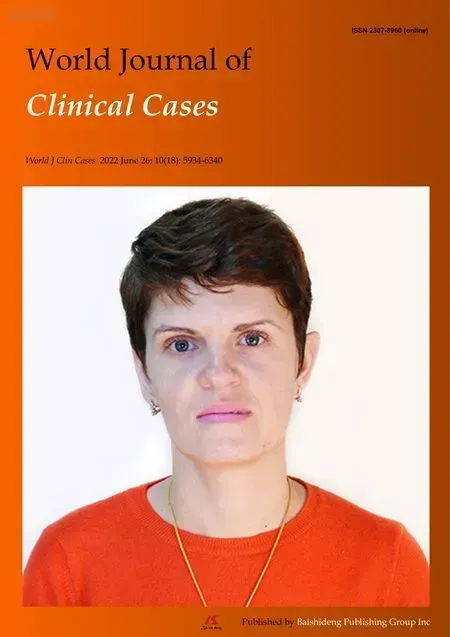 World Journal of Clinical Cases2022年17期
World Journal of Clinical Cases2022年17期
- World Journal of Clinical Cases的其它文章
- Repetitive transcranial magnetic stimulation for post-traumatic stress disorder:Lights and shadows
- Response to dacomitinib in advanced non-small-cell lung cancer harboring the rare delE709_T710insD mutation:A case report
- Loss of human epidermal receptor-2 in human epidermal receptor-2+breast cancer after neoadjuvant treatment:A case report
- Tumor-like disorder of the brachial plexus region in a patient with hemophilia:A case report
- High-frame-rate contrast-enhanced ultrasound findings of liver metastasis of duodenal gastrointestinal stromal tumor:A case report and literature review
- Gitelman syndrome:A case report
